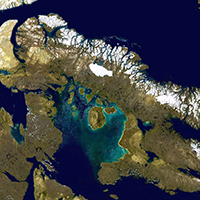Physical and chemical characteristics of 1300 lakes and ponds across the Canadian Arctic
Characteristics of Canadian Arctic lakes and ponds

Accepted: 25 August 2020
Supplementary: 107
HTML: 255
All claims expressed in this article are solely those of the authors and do not necessarily represent those of their affiliated organizations, or those of the publisher, the editors and the reviewers. Any product that may be evaluated in this article or claim that may be made by its manufacturer is not guaranteed or endorsed by the publisher.
Authors
Lakes and ponds are a major feature of the Arctic landscape and are recognized as effective ‘sentinels of change’. Here we present water chemistry characteristics of lakes and ponds (n=1300 with 26 variables) across the Canadian Arctic collated from published studies. We also extracted geological and ecoregion data in an attempt to determine the key drivers. In general, most lakes were shallow (85.4%, <10 m), nutrient (phosphorus) poor (oligotrophic = 45.6% and ultra-oligotrophic = 24.8%), located at low elevation (66.5%, <200 m asl), close to coastlines (72.5%, 0-50 km), and underlain by sedimentary geology (66.5%). The first two components from Principal Component Analysis explained 49.3% of the variation in the dataset; the first component was dominated by conductivity/carbonate materials, and the second component suggested allochthonous inputs of phosphorus. In general, bedrock geology is the primary driver of water chemistry; as such, there were major differences between lakes underlain by igneous and sedimentary rocks. Those on sedimentary bedrock tend to have higher pH, nutrients and higher inorganic ion concentrations.
Edited by
Michela Rogora, CNR-IRSA Verbania, ItalyHow to Cite
Similar Articles
- Enlou ZHANG, Enfeng LIU, Richard JONES, Peter LANGDON, Xiangdong YANG, Ji SHEN, A 150-year record of recent changes in human activity and eutrophication of Lake Wushan from the middle reach of the Yangze River, China , Journal of Limnology: Vol. 69 No. 2 (2010)
- Federico Marrone, Valentina Pieri, Souâd Turki, Giampaolo Rossetti, The Recent non-marine ostracods of Tunisia: an updated checklist with remarks on their regional distribution patterns and ecological preferences , Journal of Limnology: Vol. 79 No. 3 (2020)
- Elisa FALASCO, Francesca BONA, Diatom community biodiversity in an Alpine protected area: a study in the Maritime Alps Natural Park , Journal of Limnology: Vol. 70 No. 2 (2011)
- Jaromir Seda, Adam Petrusek, Daphnia as a model organism in limnology and aquatic biology: some aspects of its reproduction and development , Journal of Limnology: Vol. 70 No. 2 (2011)
- Leslie P. Ruse, Helen M. Greaves, Carl D. Sayer, Jan C. Axmacher, Consequences of pond management for chironomid assemblages and diversity in English farmland ponds , Journal of Limnology: Vol. 77 No. s1 (2018): Recent advances in the study of Chironomidae: An overview
- Michał WOSZCZYK, Achim BECHTEL, Roman CIEŚLIŃSKI, Interactions between microbial degradation of sedimentary organic matter and lake hydrodynamics in shallow water bodies: insights from Lake Sarbsko (northern Poland) , Journal of Limnology: Vol. 70 No. 2 (2011)
- Rosario MOSELLO, Alberto BARBIERI, Maria Cristina BRIZZIO, Alcide CALDERONI, Aldo MARCHETTO, Stefania PASSERA, Michela ROGORA, Gabriele TARTARI, Nitrogen budget of Lago Maggiore: the relative importance of atmospheric deposition and catchment sources , Journal of Limnology: Vol. 60 No. 1 (2001)
- Antonella CATTANEO, Michèle DE SÈVE, Giuseppe MORABITO, Rosario MOSELLO, Gabriele TARTARI, Periphyton changes over 20 years of chemical recovery of Lake Orta, Italy: differential response to perturbation of littoral and pelagic communities , Journal of Limnology: Vol. 70 No. 2 (2011)
- Marina Vilenica, Natalija Vučković, Zlatko Mihaljević, Littoral mayfly assemblages in South-East European man-made lakes , Journal of Limnology: Vol. 78 No. 1 (2019)
- Stefan Andjus, Nadja Nikolic, Valerija Dobricic, Ana Marjanovic, Zoran Gacic, Goran Brankovic, Maja Rakovic, Momir Paunovic, Contribution to the knowledge on the distribution of freshwater sponges – the Danube and Sava rivers case study , Journal of Limnology: Vol. 77 No. 2 (2018)
<< < 71 72 73 74 75 76 77 78 79 80 > >>
You may also start an advanced similarity search for this article.
-
Jonathan B. Martin, Andrea J. Pain, Ellen E. Martin
-
Zhizhong Li, Madjid Hadioui, Kevin J. WilkinsonNanomaterials : 2023

 https://doi.org/10.4081/jlimnol.2020.1973
https://doi.org/10.4081/jlimnol.2020.1973





